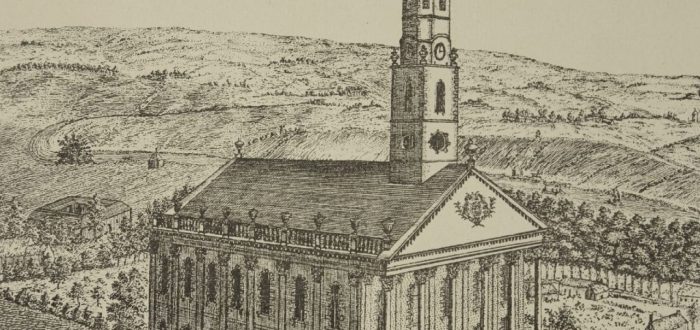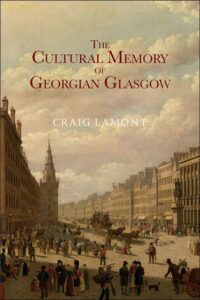In this guest post, Dr Craig Lamont (University of Glasgow) explores how we can go about rediscovering and reimagining Georgian Glasgow.
When I embarked on the ‘Georgian Glasgow’ PhD project in 2012, I did not know all that much about the Georgian era. My knowledge of Glasgow, shaped almost completely by the 20th century, was soon put to the test. It was a Collaborative Doctoral Award: a partnership between Glasgow Life and the University of Glasgow (PI: Prof Murray Pittock). I worked toward a traditional thesis and viva exam, but I gained invaluable experiences with museum staff, including conservators, language and learning officers, and curators, all working toward the 2014 exhibition How Glasgow Flourished: 1714-1837. I quickly learned that the words ‘Georgian’ and ‘Glasgow’ were not very compatible. Most history that came before razor-gangs, bevvy culture, Charles Rennie Mackintosh, shipbuilding on the Clyde and heavy industrialisation lived very much in the shadows of these modern icons. In the library I found three separate studies on Georgian London (1945, reissued in 1962 and 1988; 1975; 2013) and two onGeorgian Dublin (1975; 2008). Where was Glasgow? In fact, where was Scotland?
This last question led me into the heart of another issue. At face value, Scotland had a mixed (long) 18th century. There were the Jacobite risings, the expansion of towns to cities, the Scottish Enlightenment. But there was also slavery. Exclusionary politics. Social unrest. Sectarianism. Quite often, these matters were dealt with by scholars and historians at a national level. Think Prebble, Fry, Devine. As I dug a little deeper I realised that the Scottish Enlightenment seemed to be an Edinburgh phenomenon. The statues of Smith and Hume on the Royal Mile, and the generally antiquated look of the place, seemed to confirm this. But I was still working on assumptions and impressions. Before long I found a spate of texts, all of which appeared in the 1990s, which thankfully looked beyond Edinburgh for the Scottish Enlightenment. These were The Aberdeen Enlightenment (1993) by Paul Wood, The Glasgow Enlightenment (1995 and recently republished) edited by Andrew Hook and Rick Sher, and Glasgow Vol. 1 (1995) edited by Tom Devine and Gordon Jackson. Not only did I learn about lesser-known Enlightenment figures, I learned that the major, global figures had a more complicated background than I had realised, often Glasgow-centric. Alexander Brodie especially has helped reposition the heart of the Scottish Enlightenment to the west, in the Old College of the University of Glasgow in the High Street. So, why was it not celebrated?
My thesis, and eventual book – The Cultural Memory of Georgian Glasgow (Edinburgh: EUP, 2021) – tries to answer this very question. In the process I also consider the many attempts by cultural bodies to explain Glasgow’s involvement in slavery, only for the notion to remain that we never deal with it, or that we cover it up. But the neglect of Glasgow’s simultaneous role in scientific improvement and philosophy via the Scottish Enlightenment and the transatlantic slave trade in wider discourse is not some nefarious conspiracy. I had to learn that, too. I had to put down the Shield of St. Mungo[1] and reflect on the nuances of cultural memory and the slow progress of generations dealing with competing agendas and new technologies shaping their ideas of the past.
As we live in the age of toppling statues and re-writing plaques, let us consider one of the most powerful examples of memory and myth in Glasgow. It resides in the People’s Palace. It is the Glassford Family Portrait. Painted c. 1767 by Archibald McLauchlan of the Foulis Academy of Fine Art, the artwork tells us many things, including the location of Glassford’s Shawfield Mansion (the window and mirror). That Glassford was a patron of the Foulis brothers’ art venture also highlights the coexistence of Enlightenment and Slavery, and the flow of slave-produced revenue into the College. But these details are often lost, and the piece has become something of a lightning rod where Glasgow and slavery are concerned. The painting was given to Glasgow Museums in 1950, and before long the notion took hold that the black slave boy at the left edge of the painting had been deliberately obscured. Elspeth King of the People’s Palace wrote to a curious descendant of Glassford in 1979 reiterating the then widely-held belief that, at some point down the line, the slave was painted over.
In 2007, the painting was moved to the Kelvingrove Art Gallery & Museum to undergo restoration work. X-ray images and professional analysis showed that the figure had merely faded and had become obscured by centuries of dirt, not paint. So, neglect rather than deception. Glasgow Museums then marked the bicentenary of the Abolition of the Slave Trade Act (1807) with an exhibition centred around the portrait. Running from August 2007 to March 2008, The Glassford Family Portrait: a Hidden Legacy was a showcase not only of the painting, with an emphasis on the slave, but the restoration technique, all accompanied by contextual objects about slavery and abolition. In Michael Morris’s article on Joseph Knight (2008), the truth of the painting is helpfully placed in the wider context of Scotland’s involvement with slavery, and James Robertson’s novel about Knight (2003).[2]
But those efforts did not put an end to the myth. In the build-up to the 2014 exhibition with which I was involved, the notion was once again put forward in the press that the slave was painted over by some shame-faced ancestor. The image in one particular newspaper article even implied the face of the slave was still obscured, when in fact the section of the portrait in question showed Glassford’s second wife, Ann Nesbit of Dean, painted over to accommodate his third wife, Lady Margaret Mackenzie. And as recently as 2018, the ‘painted-over slave’ has drawn criticism. In other words, myths die hard. This is one of the principle truths of cultural memory. All this despite repeated efforts to make the true legacy of the painting more accessible, as in Anthony Lewis’s piece (2018) on the Legacies of Slavery in Glasgow Museums and Collections website.[3]
Even today, it is difficult for Georgian Glasgow to be conjured, so powerful are those modern images. This is in spite of new scholarship, popular histories, exhibitions, plays, and other events. Perhaps there is no one place to affect change, but rather a culmination of movements over time, transcending generations and shaping new ideas. Just as the restoration of an old painting can reveal new truths, so too can histories be brought into new light and understanding. Glasgow is, for many of us, a special city. But we can, and should, extend more curiosity across Scotland and find, as many friends and colleagues who have published on this very blog have found, more connections with the past worth remembering.
[1] My supervisor, Murray Pittock, came up with this term to describe passages of my thesis which were overzealously pro-Glasgow.
[2] Michael Morris, ‘Joseph Knight: Scotland and the Black Atlantic’, International Journal of Scottish Literature 4 (2008): https://www.ijsl.stir.ac.uk/issue4/morris.htm
[3] Anthony Lewis, ‘John Glassford’s Family Portrait’: https://glasgowmuseumsslavery.co.uk/2018/08/14/john-glassfords-family-portrait/


